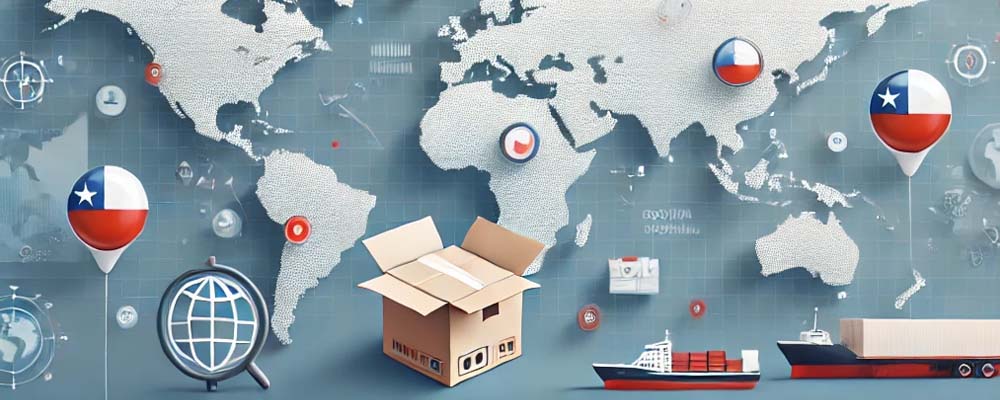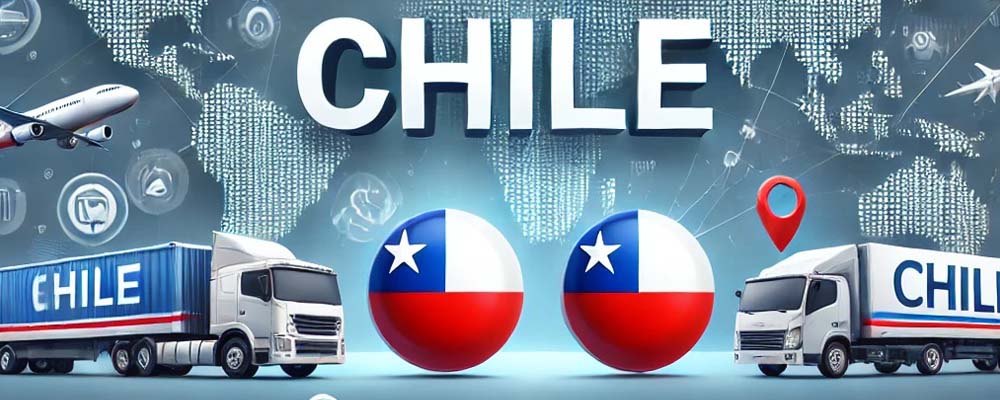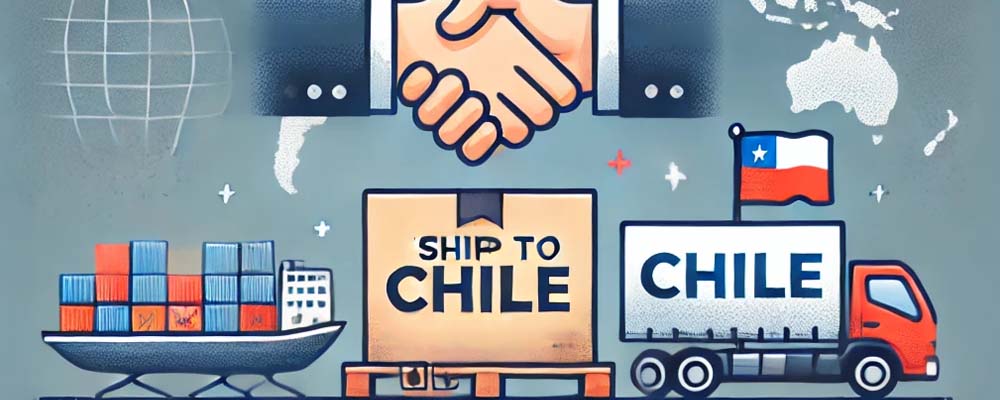
Shipping to Chile presents numerous opportunities for businesses and individuals in the logistics, import-export, and e-commerce sectors. With Chile’s robust trade network, modern infrastructure, and strategic geographic location in Latin America, it stands as a prime destination for international shipping. However, navigating the complexities of Chilean customs regulations, documentation requirements, and the country’s vast geography is critical for ensuring smooth delivery processes.
In this comprehensive guide, we’ll provide essential tips and insights for freight forwarders, logistics providers, customs brokers, e-commerce businesses, and other stakeholders on how to ship to Chile effectively. By following these guidelines, you can optimize shipping costs, minimize delays, and ensure compliance with local regulations.
1. Overview of Chile’s Trade Environment
Chile is known for its open economy, ranking high in economic freedom and trade facilitation in Latin America. The country has numerous free trade agreements (FTAs) with over 60 economies, including the United States, the European Union, and China, offering businesses favorable trade conditions and tariff reductions.
Key Trade Highlights:
- Chile’s Economy: Chile has a robust export-driven economy with key industries including mining, agriculture, and manufacturing.
- Key Trade Partners: The United States, China, Japan, and Brazil are Chile’s top trading partners.
- Ports and Logistics Infrastructure: Chile boasts several major seaports, including the Port of Valparaíso, San Antonio, and Coronel, which handle a significant portion of the country’s imports and exports.
Chile’s strategic position as a member of the Pacific Alliance makes it a prime gateway to other Latin American markets. However, to maximize the benefits of this trade environment, understanding the intricacies of Chile’s import/export processes is vital.
Target Audience Considerations:
- Freight Forwarders: Understanding the demand for ocean freight and available port facilities is crucial for maximizing capacity and cost-efficiency.
- Customs Brokers: Chile’s customs processes are straightforward but require careful documentation to avoid delays.
- Importers/Exporters: Taking advantage of Chile’s FTAs can result in significant cost savings.
 2. Shipping Methods to Chile
2. Shipping Methods to Chile
There are two primary shipping methods for moving goods to Chile: air freight and ocean freight. The best method depends on the nature of the goods, shipping costs, delivery timeline, and the importer’s preferences.
Ocean Freight to Chile
Ocean freight is the most common and cost-effective shipping method for moving large volumes of goods to Chile. This option is widely preferred for heavy or bulky shipments, as well as for non-time-sensitive goods.
Major Shipping Ports in Chile:
- Valparaíso Port: One of Chile’s busiest ports, handling general cargo, container shipments, and refrigerated goods.
- San Antonio Port: Located near Santiago, this is another key port with excellent access to inland markets.
- Coronel Port: Specialized in handling bulk cargo, particularly from the mining and forestry sectors.
Ocean Freight Considerations:
- Container Types: Standard 20-foot or 40-foot containers are commonly used for shipping to Chile. Refrigerated containers are also available for temperature-sensitive goods.
- Transit Times: Ocean freight transit times to Chile vary depending on the point of origin. For example, shipping from the U.S. typically takes 20-30 days, while shipping from Asia can take 30-40 days.
- LCL vs. FCL: For smaller shipments, Less than Container Load (LCL) shipping allows importers to share container space, reducing costs. Full Container Load (FCL) shipping is ideal for larger shipments that require an entire container.
Air Freight to Chile
Air freight is a faster, but often more expensive, option for shipping to Chile. It’s suitable for high-value or time-sensitive goods, such as electronics, pharmaceuticals, or fashion items.
Key Considerations for Air Freight:
- Airports: Santiago International Airport (SCL) is Chile’s primary hub for international air cargo.
- Transit Times: Air freight typically takes 1-3 days from major global hubs like Miami, Los Angeles, or Madrid.
- Cost: While air freight is faster, it can be significantly more expensive than ocean freight, making it more suitable for urgent shipments or goods with higher margins.
Target Audience Considerations:
- Freight Forwarders and Logistics Providers: Offering a mix of ocean and air freight options allows you to cater to varying client needs, from bulk commodities to high-value items.
- E-commerce Businesses: Air freight is ideal for fast delivery of products sold online, ensuring customer satisfaction and repeat business.
3. Customs Procedures and Regulations in Chile
Understanding Chile’s customs regulations is crucial for avoiding delays and ensuring compliance. Chile’s customs processes are relatively efficient, but importers and exporters must adhere to strict documentation and labeling requirements.
Key Documents Required for Shipping to Chile:
- Bill of Lading (BOL) or Air Waybill (AWB): This serves as the primary shipping document.
- Commercial Invoice: Must detail the nature of goods, their value, and the terms of sale.
- Packing List: Provides information on the contents of each package in the shipment.
- Certificate of Origin: Often required to take advantage of tariff benefits under Chile’s FTAs.
- Import Declaration: Submitted to Chilean Customs for clearance.
Duties and Taxes:
- Customs Duties: Chile’s average tariff rate is low, generally around 6%. However, many goods may be exempt from duties under Chile’s numerous FTAs.
- Value-Added Tax (VAT): Imports are subject to a standard VAT rate of 19%, calculated on the cost, insurance, and freight (CIF) value of the goods.
- Special Taxes: Certain goods, such as luxury items, alcohol, or tobacco, may be subject to additional taxes.
Customs Clearance Process:
Chile uses an electronic customs clearance system known as SICEX (Sistema Integrado de Comercio Exterior), which streamlines the import process. Shipments must be declared upon arrival, and customs officials may inspect goods to ensure compliance with import regulations.
Target Audience Considerations:
- Customs Brokers: Staying up-to-date with Chilean customs procedures is vital for ensuring smooth clearance of goods.
- Importers and Exporters: Proper documentation and adherence to import regulations will minimize the risk of delays and fines.
 4. Navigating Chile’s Regulatory and Compliance Landscape
4. Navigating Chile’s Regulatory and Compliance Landscape
In addition to customs requirements, businesses shipping to Chile must adhere to a range of regulatory and compliance standards, depending on the nature of the goods.
Product Labeling Requirements:
Chile has strict labeling regulations for consumer goods, particularly food products. Labels must be in Spanish and include information such as the product name, ingredients, expiration date, and the country of origin. Failure to comply with these requirements can result in fines or rejection of the goods by customs.
Sanitary and Phytosanitary (SPS) Measures:
Chile enforces strict sanitary and phytosanitary regulations to protect human, animal, and plant health. Importers of agricultural products, pharmaceuticals, and chemicals must obtain the necessary permits and certificates from Chilean authorities, such as the Servicio Agrícola y Ganadero (SAG) or the Instituto de Salud Pública (ISP).
Licensing and Permits:
Certain goods, such as firearms, explosives, or hazardous materials, require special import licenses. Additionally, telecommunications equipment must meet Chilean standards and may require approval from the Subsecretaria de Telecomunicaciones (SUBTEL).
Target Audience Considerations:
- Manufacturers and Producers: Ensuring product compliance with Chile’s labeling and safety standards is crucial for market entry.
- E-commerce Businesses: Understanding the requirements for shipping products like electronics or cosmetics will help you avoid delays and legal issues.
5. Best Practices for Cost Optimization and Risk Management
Shipping to Chile can involve significant costs, especially when dealing with long transit times, customs duties, and taxes. However, there are several strategies businesses can employ to optimize costs and mitigate risks.
Tips for Reducing Shipping Costs:
- Consolidate Shipments: For smaller shipments, using a freight consolidator can help reduce costs by sharing container space with other importers.
- Leverage Free Trade Agreements: Take full advantage of Chile’s FTAs to reduce or eliminate customs duties on eligible products.
- Negotiate with Shipping Providers: Freight forwarders and logistics companies often offer discounts for long-term contracts or higher shipping volumes.
- Optimize Packaging: Minimizing the size and weight of packages can significantly reduce shipping and handling costs.
Managing Risks in Shipping:
- Insurance: Always insure high-value shipments to protect against potential damage, loss, or theft during transit.
- Supply Chain Visibility: Use tracking technologies and software to monitor shipments in real-time, ensuring timely delivery and minimizing delays.
- Plan for Delays: Factor in potential customs delays or disruptions in the shipping route when planning your delivery timelines.
Target Audience Considerations:
- Freight Forwarders and Logistics Providers: Offering cost-saving solutions, such as freight consolidation or insurance options, can attract more clients.
- Importers and Exporters: Reducing shipping costs and managing risks will help you maintain profitability in the competitive Chilean market.
 6. Environmental and Sustainability Considerations
6. Environmental and Sustainability Considerations
Sustainability has become a key factor in global supply chains, and shipping to Chile is no exception. Companies that prioritize eco-friendly shipping practices can differentiate themselves in the marketplace, particularly as environmental regulations tighten globally.
Reducing the Environmental Impact of Shipping:
- Carbon Offsetting: Consider partnering with shipping providers that offer carbon offset programs, allowing you to minimize the environmental footprint of your shipments to Chile.
- Sustainable Packaging: Reducing the use of plastic packaging or switching to recyclable materials can lower waste and appeal to eco-conscious consumers in Chile.
- Optimizing Shipping Routes: Working with logistics providers that use optimized shipping routes and modes of transport can reduce emissions. For example, consolidating shipments and using ocean freight for non-urgent goods can lower the carbon footprint.
Chile’s Environmental Regulations:
Chile is committed to environmental sustainability and has various regulations in place to reduce pollution and manage waste. Businesses shipping to Chile should be aware of the country’s extended producer responsibility (EPR) laws, which mandate that producers are responsible for the waste management of their products, particularly for packaging materials.
Target Audience Considerations:
- Manufacturers and Producers: Offering environmentally sustainable products with eco-friendly packaging can help you stand out in the Chilean market.
- Freight Forwarders and Logistics Providers: Providing sustainable shipping solutions, such as carbon-neutral shipping, will appeal to clients seeking to meet their corporate social responsibility goals.
7. Key Challenges and Solutions for Shipping to Chile
While Chile offers a favorable trade environment, businesses must be prepared to face several challenges when shipping goods to the country. Being aware of these challenges and having strategies to address them will ensure a smoother process.
Common Shipping Challenges:
- Geographical Barriers: Chile’s unique geography, with the Andes mountains to the east and a long Pacific coastline, can create logistical difficulties, especially when shipping to remote or rural areas.
- Customs Delays: Although Chile’s customs processes are generally efficient, incomplete documentation or non-compliance with regulations can lead to delays at the border.
- Cost Management: Rising fuel costs and fluctuating exchange rates can impact shipping costs, particularly for ocean freight shipments.
- Language Barrier: For non-Spanish-speaking businesses, navigating Chile’s import regulations and communicating with local partners may present a challenge.
Solutions and Best Practices:
- Partner with Local Experts: Working with local customs brokers, freight forwarders, and logistics providers can help overcome geographical and language barriers, ensuring smoother delivery processes.
- Advanced Planning: Build extra time into your shipping schedule to accommodate any potential delays, especially during peak shipping seasons.
- Leverage Technology: Implement supply chain management software and real-time tracking tools to improve visibility over your shipments and mitigate risks.
Target Audience Considerations:
- Freight Forwarders: Offering comprehensive end-to-end solutions that include customs brokerage and local partnerships will provide added value to your clients.
- Customs Brokers: Having expertise in Chile’s customs processes will make you an invaluable partner for businesses seeking to streamline their shipments.
 Conclusion
Conclusion
Shipping to Chile offers immense opportunities for businesses in logistics, e-commerce, and manufacturing, but it requires careful planning and attention to detail. From understanding Chile’s customs regulations and choosing the right shipping methods to addressing environmental concerns and managing costs, businesses that take a proactive approach will be better positioned for success.
Final Tips:
- Stay Informed: Regulations and shipping practices can change, so staying up-to-date with the latest information will help you avoid unnecessary delays and costs.
- Partner Wisely: Work with experienced freight forwarders, customs brokers, and logistics providers who understand the complexities of the Chilean market.
- Customer-Centric Shipping: Whether you’re shipping B2B or B2C, ensuring that your customers receive their goods on time and in good condition is essential for maintaining a strong reputation in the market.
By following the essential tips and insights outlined in this guide, you can navigate the complexities of shipping to Chile with confidence, ensuring that your goods reach their destination efficiently and in compliance with all local regulations.




 2. Shipping Methods to Chile
2. Shipping Methods to Chile 4. Navigating Chile’s Regulatory and Compliance Landscape
4. Navigating Chile’s Regulatory and Compliance Landscape 6. Environmental and Sustainability Considerations
6. Environmental and Sustainability Considerations Conclusion
Conclusion



